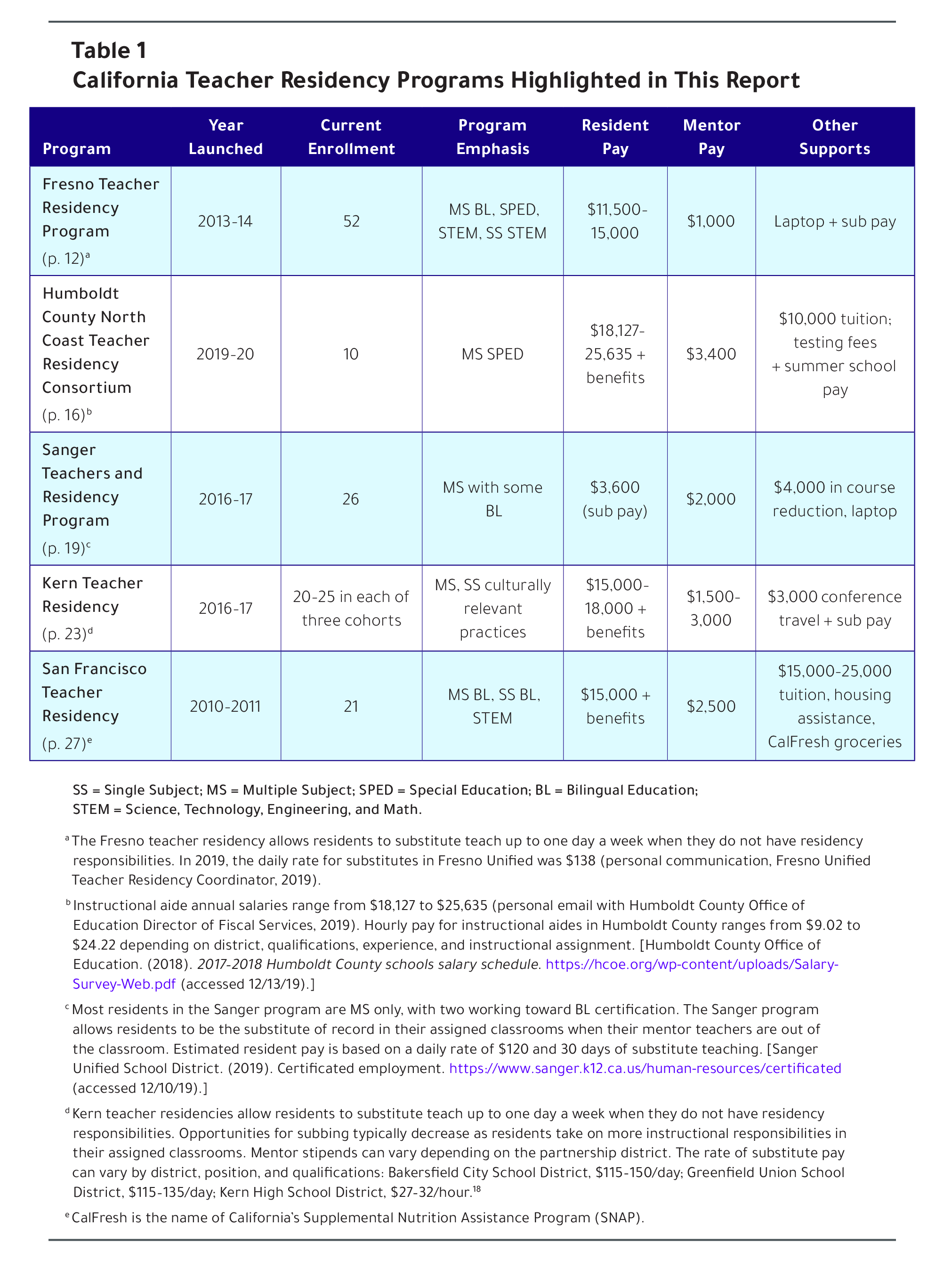Sustainable Strategies for Funding Teacher Residencies: Lessons From California

Like many states, California has faced acute teacher shortages for a number of years, particularly in special education, mathematics, science, and bilingual education. Research suggests that a system of high-quality teacher residencies has the potential to address multiple areas of concern with the state’s educator workforce, including teacher shortages and underprepared educators. High-quality teacher residencies can prepare effective teachers who stay in the profession; often provide financially feasible pathways for candidates; and, when adequately funded, are more likely to recruit teachers of color than other pathways into teaching.
Developing and sustaining high-quality residency programs requires resources, and, in 2018-19, California appropriated $75 million dollars to establish the Teacher Residency Grant Program. Under this program, teacher residencies can receive a competitive grant of up to $20,000 per resident to launch or expand programs to recruit and prepare teachers in high-need areas. These state-financed residency grants have provided seed funding to jump-start participating programs—or, in some cases, to scale existing programs. However, recognizing that state funding may not always be available, particularly in the wake of COVID-19, which has placed unprecedented stress on state budgets, programs are working toward greater financial sustainability.
This report shares examples from California of partners working together to bring local resources to their residencies to improve sustainability. The report sets the California context and briefly describes how securing funding for residencies can help to address teacher shortages, while increasing the diversity of the teaching workforce. The report also provides concrete strategies that programs can use to move toward long-term sustainable funding, with examples of how specific programs in California have successfully implemented select strategies. These strategies could be useful to districts, teacher preparation programs, community leaders, and state policymakers to help inform teacher residency design and supports.
Residencies as a Response to California’s Policy Challenges
California has invested heavily in teacher residencies, which build on the medical residency model and are based on the understanding that teacher candidates need to learn to practice in authentic contexts with skilled mentors. The Teacher Residency Grant Program offers competitive grants of up to $20,000 per resident for teacher residencies to launch or expand programs to recruit and prepare teachers in these high-need areas, with a requirement that grantees also provide local matching funds to support the program. The legislation also required several conditions common to high-quality residencies, including a partnership between a local education agency (LEA) and an accredited teacher preparation program, placement of residents alongside an experienced mentor teacher at least half-time for a full academic year (while residents are also taking coursework), professional development and stipends/ release time for mentor teachers, continued induction supports for residency graduates, and a requirement that residency graduates commit to teaching in the sponsoring district for 4 years upon program completion.
Increasing Equitable Access to High-Quality Teacher Preparation
Teacher residencies can look very different depending on the context, but research has identified some common characteristics of high-quality residencies that set them apart from other traditional teacher preparation programs or most alternative pathways that place teachers in classrooms before they have completed their training for teaching.
First, strong residencies are developed in partnership between a school district and a teacher education program to address the specific instructional and hiring needs of the partner district, which often includes recruiting a diverse pool of candidates to fill certain high-need subject areas. Second, residencies provide yearlong supervised teaching experiences before candidates become the teacher of record; residents typically spend 4 to 5 days a week working in a classroom under the guidance of an experienced mentor teacher, gradually taking on more responsibilities over the course of the residency year. Third, residencies offer teacher preparation programming that tightly integrates coursework with classroom practice.
These and a few other common characteristics, including financial supports for candidates (see “What Is a Teacher Residency?”), set residencies apart from other teacher preparation pathways and provide a design framework for high-quality preparation. Because these characteristics are part of the California legislation authorizing the Teacher Residency Grant Program, the residencies highlighted in this report share all of these characteristics, albeit to different extents.
What Is a Teacher Residency?
High-quality teacher residency programs share common characteristics that have been identified in research as essential characteristics. Residencies typically:
- consist of strong partnerships between school districts/LEAs, universities, and sometimes other entities;
- tightly integrate coursework about teaching and learning with classroom practice;
- require a full year of residency teaching alongside an accomplished mentor teacher;
- recruit diverse candidates for specific district instructional and hiring needs, often in shortage areas;
- provide financial support, often in exchange for the resident’s commitment to teach in the district for a minimum number of years;
- place cohorts of residents in “teaching schools” that model evidence-based practices with diverse learners; and
- offer ongoing mentoring and support for residency graduates hired by the partner LEA after they enter the teaching workforce.

This report is published jointly by the Learning Policy Institute, Prepared to Teach and EdPrepLab, an initiative of Bank Street Graduate School of Education and the Learning Policy Institute.
Sustainable Strategies for Funding Teacher Residencies: Lessons From California by Cathy Yun and Karen DeMoss is licensed under a Creative Commons Attribution-NonCommercial 4.0 International License.
This research was supported by the Bill & Melinda Gates Foundation and the S. D. Bechtel, Jr. Foundation. Funding for the Educator Preparation Laboratory is provided by the Carnegie Corporation of New York and the W. Clement and Jessie V. Stone Foundation. Core operating support for the Learning Policy Institute is provided by the Heising-Simons Foundation, Raikes Foundation, Sandler Foundation, and William and Flora Hewlett Foundation. Core support for Prepared To Teach is provided by the Margaret A. Cargill Philanthropies and Carnegie Corporation of New York. We are grateful to them for their generous support. The ideas voiced here are those of the authors and not those of our funders.
